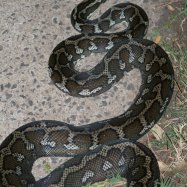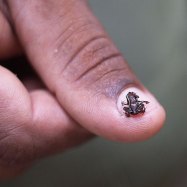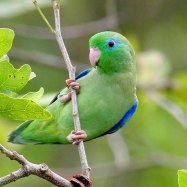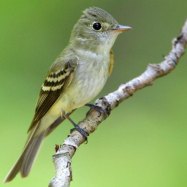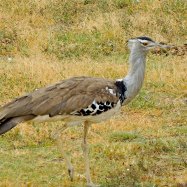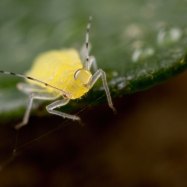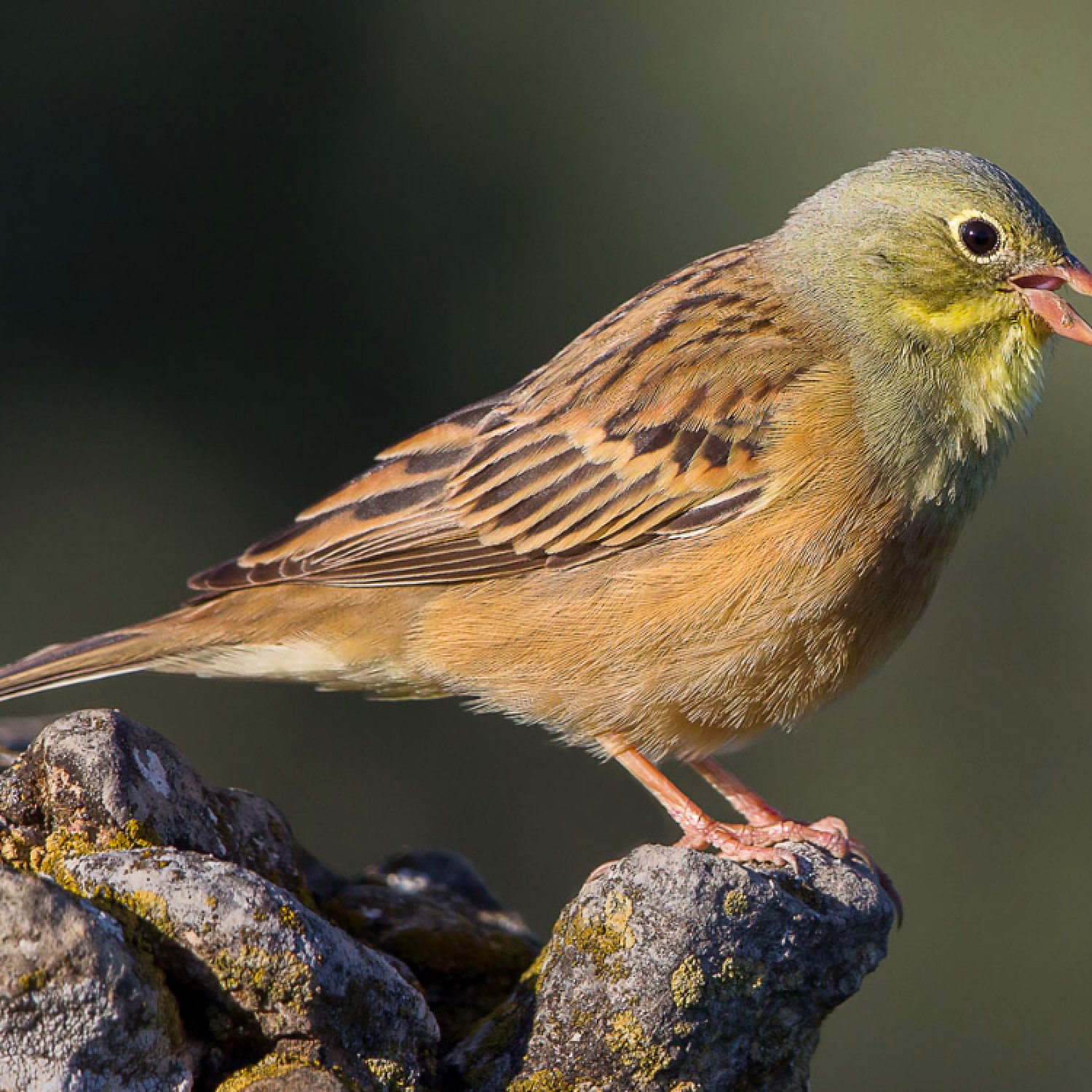
Ortolan Bunting
16-17 cm
Did you know that the Ortolan Bunting is a small bird with a stocky body and short tail? These beautiful birds, known for their distinctive yellow and green plumage, can be found breeding in open country habitats with scattered shrubs and trees. At just 16-17 cm in length, they may be small in size but their captivating songs and unique appearance make them a favorite among bird enthusiasts. #OrtolanBunting #Emberizidae #birdwatching
Animal Details Summary:
Common Name: Ortolan Bunting
Kingdom: Animalia
Habitat: Open woodland, scrubland, and grassland habitats.
The Enigmatic Ortolan Bunting: A Small Bird with a Dazzling Presence
It's a late summer morning in the open countryside, and you hear the faint sound of a bird singing in the distance. As you slowly make your way through the fields, you catch a glimpse of a small bird perched on a branch. Its striking plumage catches your eye immediately – a vibrant yellow-brown body, black wings, and a masked face. This little bird is the Ortolan Bunting, one of the most enigmatic and fascinating birds in the world Ortolan Bunting.The Ortolan Bunting (Emberiza hortulana) is a small passerine bird found across Europe and Asia. It belongs to the Emberizidae family, commonly known as buntings, and is a member of the avian order Passeriformes. Its name comes from the French word "ortolan," meaning little garden. This is due to the bird's affinity for open woodland, scrubland, and grassland habitats, often found in garden-like settings.
Ortolan Buntings have been a subject of fascination for centuries, with their unique appearance and elusive behavior captivating bird watchers and scientists alike. In this article, we will dive deeper into the world of the Ortolan Bunting, exploring its habitat, diet, physical characteristics, and why it continues to be a mysterious and beloved bird.
Habitat and Distribution
The Ortolan Bunting is primarily found in Europe, with a small population in Asia. Its range stretches from France and the Iberian Peninsula in the west to western Siberia in the east. It is a migratory bird, spending winters in Africa and returning to its breeding grounds in Europe during the warmer months Oranda Goldfish.Within its breeding range, the Ortolan Bunting prefers open country habitats with scattered shrubs and trees. It can be found in various types of habitat, including forests, meadows, farmlands, and even urban parks. This adaptability has allowed the Ortolan Bunting to thrive in different environments, making it a common sight for bird enthusiasts.
In recent years, there has been a significant decline in the Ortolan Bunting population due to loss of habitat and illegal hunting. This has led to the species being classified as a Near Threatened species on the International Union for Conservation of Nature (IUCN) Red List. Conservation efforts are crucial for the survival of this beautiful bird.
Feeding and Diet
Ortolan Buntings are omnivorous, meaning they eat a variety of foods. Their diet consists mainly of seeds, insects, and berries, with insects being the preferred food during breeding season. They forage on the ground, using their stout beaks to probe for food in the soil and rip open insect nests.Their preference for seeds and berries also makes them important for seed dispersal in their habitat, helping with the growth and regeneration of plant life. This shows the significant role these small birds play in their ecosystem.
Physical Characteristics
The Ortolan Bunting is a small bird, measuring only 16-17 cm in length and 14-16 cm in height. Its body is stocky, with a short tail, giving it a compact appearance. The male and female have distinct differences in plumage, making them easily distinguishable.The male Ortolan Bunting has a striking and vibrant appearance. Its head, throat, and breast are a vibrant yellow-brown color, while the upperparts are a dark chestnut brown. The wings are black with a white stripe, and the face is adorned with a black mask. In contrast, the female has a duller appearance, with a brownish-grey body and a lighter-colored mask.
During the breeding season, the male Ortolan Bunting also develops extra bright colors on its head and throat, enhancing its attractiveness to females. This colorful display is one of the reasons this bird is adored by bird watchers and nature enthusiasts.
A Captivating Courtship Display
The courtship display of the Ortolan Bunting is a mesmerizing sight to behold. The male will perch on a branch, singing a beautiful and complex song, while spreading and fluttering its wings and tail. This display not only attracts females but also serves as a territorial display to ward off other males.Once a pair is formed, the male continues to sing to attract the attention of his mate, and the female responds with a softer call. They will also engage in a unique bonding behavior where they rub their heads and bills together. This bond lasts beyond the breeding season, with the pair often coming back to the same breeding site year after year.
A Feast for the Senses
In many cultures, the Ortolan Bunting is considered a delicacy, and this is where the bird's enigmatic reputation truly shines. For centuries, it has been hunted for its meat, with special ceremonies and rituals surrounding its consumption.During the autumn migration, the Ortolan Bunting fattens up for its long journey back to Africa. This is when it becomes a prime target for hunters. The birds are captured and kept in cages for a few weeks, feeding on a diet of millet and figs until they reach a suitable size for consumption.
Traditionally, the Ortolan Bunting is prepared by plucking the feathers, and after being slit open, the whole bird is roasted over a fire. It is then placed on a slice of bread with butter before being eaten whole. This has been deemed by some as a "gastronomic orgy," with the experience titillating all the senses.
Conservation Efforts and Controversy
The Ortolan Bunting's declining population has led to conservation efforts to protect the species. In France, where the bird is hunted illegally, there have been efforts to enforce strict hunting regulations and create protected areas for Ortolan Buntings to breed and rest.However, these conservation efforts have also been met with controversy, as the traditional practice of consuming the bird remains a highly valued cultural tradition in some countries. Authorities and conservationists are struggling to find a balance between preserving cultural traditions and protecting a species in danger.
Unlocking the Mysteries of the Ortolan Bunting
The Ortolan Bunting continues to be a mysterious and elusive bird, despite its widespread presence in Europe and Asia. Its enigmatic nature, unique appearance, and captivating courtship display make it a favorite among bird enthusiasts.However, with declining populations and controversial hunting practices, the future of this beautiful bird remains uncertain. It is up to us to appreciate and protect this species, ensuring that future generations can also experience the joy of encountering the elusive Ortolan Bunting in the wild.

Ortolan Bunting
Animal Details Ortolan Bunting - Scientific Name: Emberiza hortulana
- Category: Animals O
- Scientific Name: Emberiza hortulana
- Common Name: Ortolan Bunting
- Kingdom: Animalia
- Phylum: Chordata
- Class: Aves
- Order: Passeriformes
- Family: Emberizidae
- Habitat: Open woodland, scrubland, and grassland habitats.
- Feeding Method: Omnivorous diet including seeds, insects, and berries.
- Geographical Distribution: Found across Europe and Asia.
- Country of Origin: Mostly found in Europe.
- Location: Ortolan Buntings breed in open country habitats with scattered shrubs and trees.
- Animal Coloration: The male has a striking plumage with a yellow-brown body, black wings, and a masked face. The female has a duller plumage.
- Body Shape: Small bird with a stocky body and short tail.
- Length: 16-17 cm
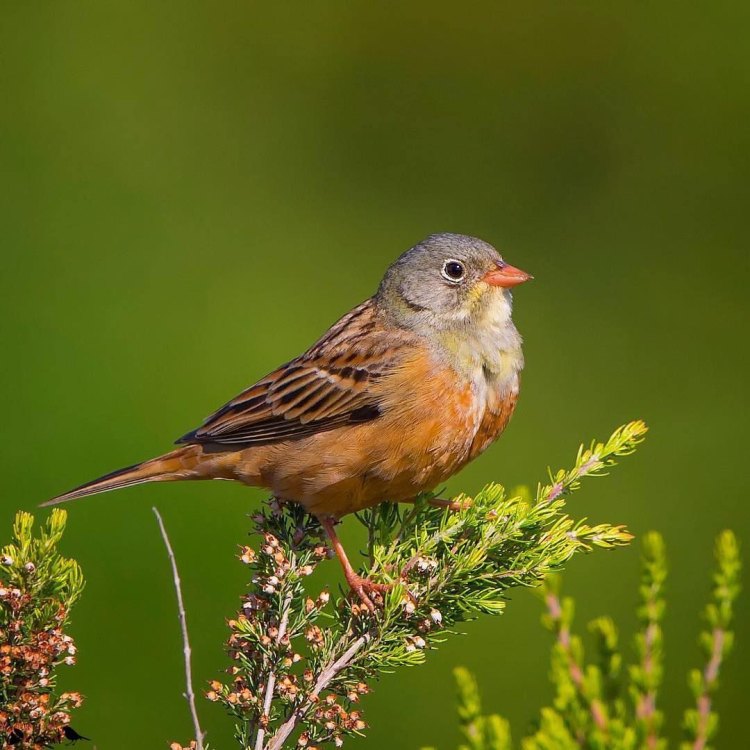
Ortolan Bunting
- Adult Size: Small
- Average Lifespan: Around 2-3 years
- Reproduction: Ortolan Buntings breed during spring and early summer.
- Reproductive Behavior: Males perform courtship displays to attract females.
- Sound or Call: The male sings a rich, melodic song.
- Migration Pattern: Migratory birds, moving to Africa for the winter.
- Social Groups: Solitary or in small flocks during migration.
- Behavior: Ortolan Buntings are known for their distinctive flight displays during courtship.
- Threats: Habitat loss and illegal trapping.
- Conservation Status: Endangered
- Impact on Ecosystem: Ortolan Buntings play a role in seed dispersal and insect control.
- Human Use: They were historically hunted as a delicacy in some countries.
- Distinctive Features: The male has a bright yellow-brown body and a masked face.
- Interesting Facts: Ortolan Buntings are known for their unique migration path and their association with gastronomy in some cultures.
- Predator: Birds of prey and mammals.
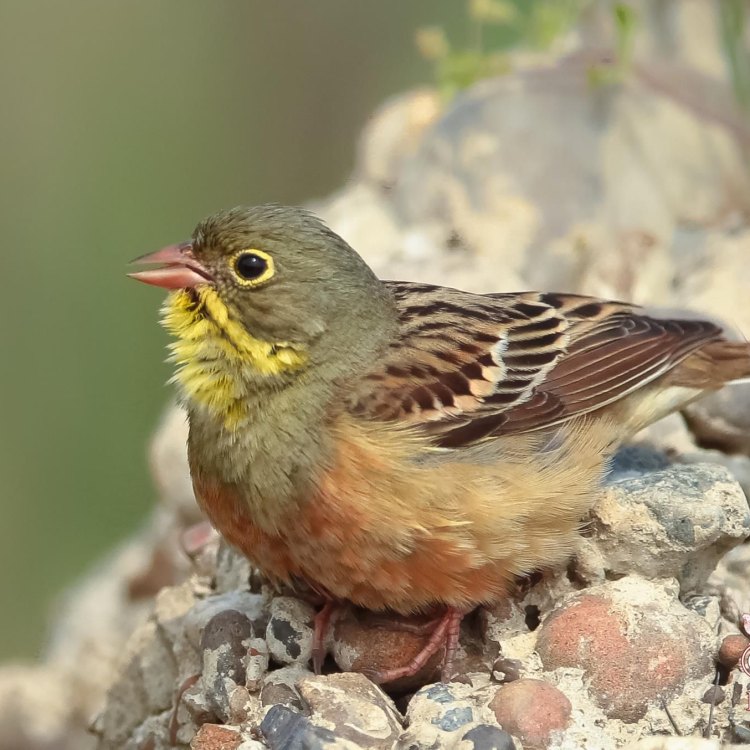
Emberiza hortulana
The Fascinating World of Ortolan Buntings: A Unique Bird with a Troubled Existence
Nestled in the grasslands and shrublands of Western and Central Europe, lives a small but striking bird known as the Ortolan Bunting. Its vibrant colors, unique migration patterns, and association with gastronomy make it a fascinating species to study. However, despite its beauty, the Ortolan Bunting is facing significant threats, leading to its endangered status. In this article, we will delve into the world of Ortolan Buntings, uncovering their distinctive features, intriguing behaviors, and the challenges they face in the wild PeaceOfAnimals.Com.Ortolan Buntings belong to the Emberizidae family, a group of small passerine birds, commonly known as buntings. These birds are native to Europe, with the largest population found in France, as well as Germany, Spain, and Italy. They belong to the genus Emberiza, which is derived from the Latin word "ember," meaning "raven." This is a nod to the bird's dark coloration, as well as its association with the Greek goddess Athena, who was often depicted with a raven on her shoulder.
Adult Ortolan Buntings are small birds, measuring around 15-16 cm in length and weighing a mere 20-25 grams. They have a wingspan of approximately 25 cm, making them very agile flyers. These birds have a relatively short lifespan, with an average of 2-3 years in the wild. However, some individuals have been known to live up to 5 years.
Like most buntings, Ortolan Buntings are monogamous and breed during spring and early summer Olive Sea Snake. The breeding season is an essential time for male Ortolans, as they perform elaborate courtship displays to attract females. These displays involve the male singing a rich, melodic song while fluttering its wings and puffing out its chest. The song is a crucial part of the courtship ritual, as it not only attracts females but also serves as a warning to rival males.
Once a pair has formed, they will construct a nest on the ground, usually in a small depression in the grass. The female will lay 3-5 eggs, which will be incubated for approximately 12 days. Once hatched, the chicks will remain in the nest for another two weeks before fledging and leaving their parents.
One of the most remarkable things about Ortolan Buntings is their migration pattern. While many birds migrate south for the winter, the Ortolan Bunting has a unique migration path, making them stand out among other migratory birds. These birds undertake long-distance migrations, moving from their breeding grounds in Europe to winter in West Africa. This journey can be as long as 3,000 kilometers, and the birds will fly non-stop for over 50 hours. This is an impressive feat for such a small bird.
During migration, Ortolan Buntings can be found either in solitary pairs or in small flocks. However, they are known for their distinctive flight displays during courtship. These displays, commonly referred to as "butterfly flights," involve the birds flying in a zigzag pattern, similar to that of a butterfly. These displays are a sight to behold and are often a highlight for birdwatchers and researchers alike.
Despite their striking beauty and unique behaviors, Ortolan Buntings face numerous threats in the wild. One of the most significant threats to their survival is habitat loss. These birds require open grasslands and shrublands for breeding, and their wintering grounds in West Africa are also under threat from human activities. Development, intensive agriculture, and urbanization have all contributed to the loss of suitable habitat for Ortolans, making it challenging for them to find suitable breeding and feeding grounds.
Another significant threat to the Ortolan Bunting is illegal trapping. In many countries, these birds are considered a delicacy and are hunted for their meat. They are captured using large nets, and their numbers have drastically declined in their native European range due to this illegal activity. Many conservation efforts have been put in place to combat this threat, including laws and regulations against trapping and efforts to educate the public about the conservation status of these birds.
Unfortunately, these threats have caused the Ortolan Bunting to become an endangered species. According to the International Union for Conservation of Nature (IUCN), their population has declined by 30% over the last ten years, and they are now considered to be critically endangered. If urgent and effective conservation measures are not put in place, these birds may face extinction in the near future.
The Ortolan Bunting plays an essential role in the ecosystem, despite its small size. They are seed dispersers, feeding on a variety of insects and seeds, helping to control insect populations and spread seeds to new areas. Additionally, their bright yellow-brown plumage makes them important prey for birds of prey, such as falcons, hawks, and eagles, and mammals like foxes and weasels. Their loss would have a ripple effect on the ecosystem, ultimately impacting other species.
Despite the Ortolan Bunting's endangered status, they hold a significant place in some cultures, particularly in France. In the past, these birds were hunted and eaten as a traditional delicacy. They were often captured and placed in a closed cage, where they were force-fed to fatten them up for consumption. This practice, known as "gavage," has been outlawed in France since 1999. However, there is still a black market for these birds, and they are considered a delicacy by some. As a result, the Ortolan Bunting remains a symbol of the beautiful and the unsettling aspects of human interactions with nature.
In conclusion, the Ortolan Bunting is a unique and captivating bird, with a distinctive appearance, fascinating behaviors, and a troubled existence. Their endangered status serves as a reminder of the fragility of our environment and the impact of human activities on our wildlife. As we continue to learn more about these birds, it is essential that we take action to protect and preserve their populations, ensuring that they continue to grace our grasslands and bring beauty to our world for generations to come.
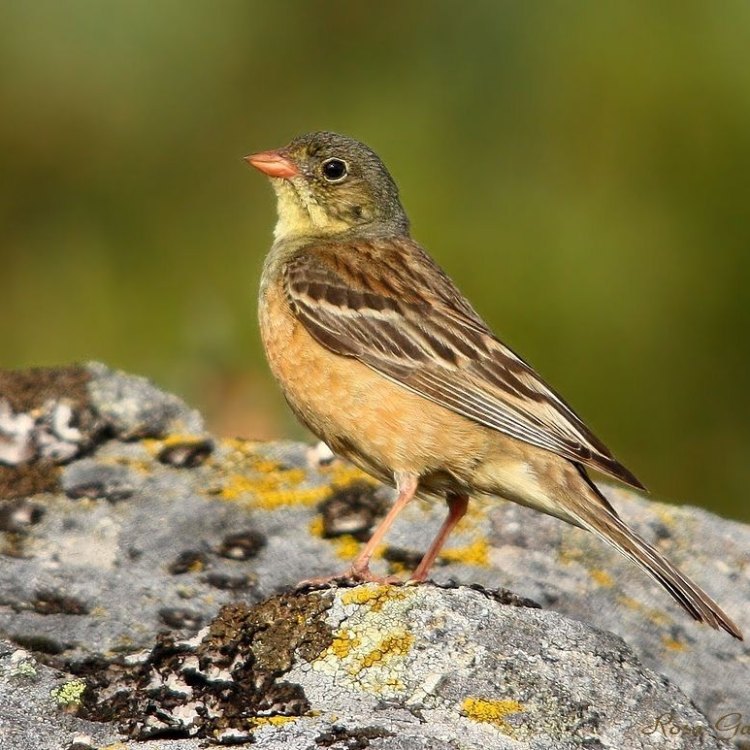
The Enigmatic Ortolan Bunting: A Small Bird with a Dazzling Presence
Disclaimer: The content provided is for informational purposes only. We cannot guarantee the accuracy of the information on this page 100%. All information provided here may change without prior notice.




